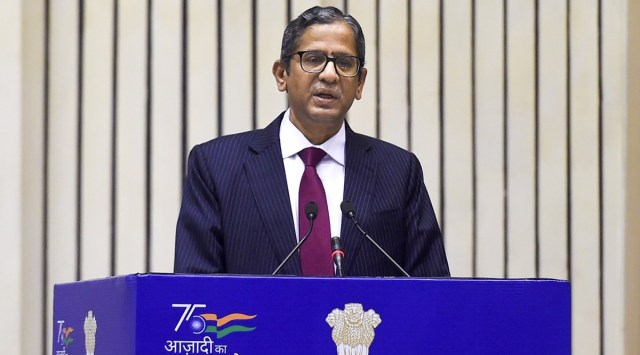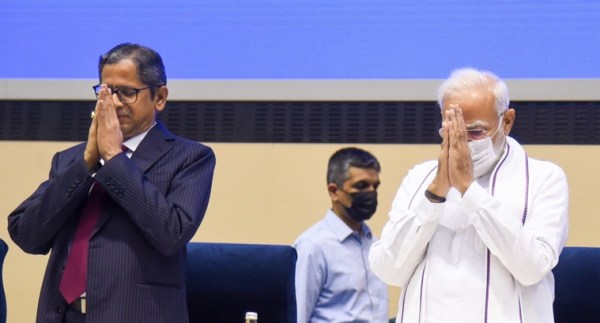Stating that “non-performance by the various wings of the executive” and “legislature not realising its full potential” are the “two major reasons” for the docket explosion in the country, Chief Justice of India N V Ramana Saturday underlined the need to increase the sanctioned strength of judges and fill existing vacancies to address the issue of pendency.
Addressing the 11th Joint Conference of Chief Ministers and Chief Justices inaugurated by Prime Minister Narendra Modi at Vigyan Bhavan in New Delhi, CJI Ramana also spoke on the need for all organs of the State to “be mindful of the Lakshman Rekha”.

“It is the harmonious and coordinated functioning among the three organs of the State that has preserved and strengthened the democratic foundations of this great nation over the last seven decades. While discharging our duties, we all must be mindful of the Lakshman Rekha. The judiciary would never come in the way of governance if it were in accordance with law. We share our anxiety and concern regarding the welfare of the people,” he said.
He stressed the need for creation of the National and State Judicial Infrastructure Authorities to address infrastructure deficiencies of courts.
Pointing to the distressing situation at the district level, the CJI said: “The environment of some district courts is such that even lady advocates feel apprehensive about entering court rooms, let alone female clients.”
On the rise in workload of the courts, he said “the 140-crore strong population of the world’s largest democracy is bound to test its judiciary… no other constitutional court in the world hears such a wide range of issues in such large numbers”.
Illustrating factors that contribute to the increase in litigation, he said farmers will not go to court if the tehsildar acts on their grievance regarding land or ration card, citizens won’t look to courts if a municipal authority or gram panchayat discharges its duties, and there won’t be land disputes – which account for 66 per cent of pendency – if revenue authorities follow due procedure while acquiring land.
Story continues below this ad
“It is beyond my understanding as to why intra and inter departmental disputes of the government or fights between PSUs and the government end up in courts,” the CJI said, adding “it is a well acknowledged fact that governments are the biggest litigants, accounting for nearly 50% of the cases”.
“Abiding by law and the Constitution is key to good governance. However, this is often ignored, and opinions of legal departments are not sought in the rush to implement executive decisions,” he said.
Contempt petitions, which happen because decisions of courts are not implemented by governments for years together, are a new category of burden on the courts, he said, adding that “deliberate inaction by governments, despite judicial pronouncements, are not good for the health of democracy”.
“The judiciary,” the CJI said, “is also confronted with the issue of the executive willingly transferring the burden of decision-making to it” and “at times, ambiguities in legislations also add to existing legal issues”.
Story continues below this ad
“If the legislature passes a law, with clarity of thought, foresight and with people’s welfare in mind, the scope for litigation gets minimised. The legislature is expected to solicit the views of the public and debate Bills, clause by clause, threadbare, before enacting a law,” he said.
 CJI Ramana with Prime Minister Narendra Modi at the meet in New Delhi on Saturday. (Photo: PTI)
CJI Ramana with Prime Minister Narendra Modi at the meet in New Delhi on Saturday. (Photo: PTI)
“Based on these examples, one can safely summarise that, often, litigation is triggered because of two major reasons. One is non-performance by the various wings of the executive. Second is the legislature not realising its full potential… these are avoidable burdens on the judicial system,” he said.
On the pendency of cases, the CJI said it is “often blamed on the judiciary”. Pointing to the “huge workload on judges,” he said “the number of cases filed and disposed of each day is unimaginable”.
Frivolous PILs, he said, are another reason for pendency. It began as a well-meaning concept but “these days, PIL has become a tool for those who want to settle political scores or corporate rivalry”. The CJI said “realising the potential for misuse, courts are now highly cautious in entertaining the same”.
Story continues below this ad
Speaking on “Indianisation of the justice delivery system”, the CJI said this means “increasing accessibility by moulding the system to suit the needs and sensibilities of the Indian population” and this “calls for inclusivity, providing access to justice, removal of language barriers, reforms in practice and procedure, development of infrastructure, filling vacancies, augmenting the strength of the judiciary and so on”.
“I am receiving many representations for introducing local languages in proceedings before the High Courts. I think the time has come now to revisit the demand and take it to a logical conclusion. The practice of law before Constitutional Courts should be based on one’s intelligence and understanding of law, and not mere proficiency in language,” he said.
Filling vacancies, he said, was an important factor in addressing pendency. “As of today, out of 1104 sanctioned posts of High Court Judges, there are 388 vacancies.”
Of the 180 recommendations made for appointments in various High Courts ever since he assumed office as CJI, the government, he said, had made 126 appointments while 50 proposals are still awaiting approval.
Story continues below this ad
“The High Courts have sent around 100 names to the Government of India. They are yet to reach us,” he said.
The CJI said that when the last such event was held in 2016, the sanctioned strength of judicial officers in the country was 20,811 as against 24,112 now — an increase of 16% in 6 years. The corresponding rise in pendency in district courts during this period was from 2.65 crore to 4.11 crore, an increase of 54.64%, he said.
“As per sanctioned strength, we have just around 20 judges per 10 lakh population, which is (an) alarming low,” he said.



 CJI Ramana with Prime Minister Narendra Modi at the meet in New Delhi on Saturday. (Photo: PTI)
CJI Ramana with Prime Minister Narendra Modi at the meet in New Delhi on Saturday. (Photo: PTI)





